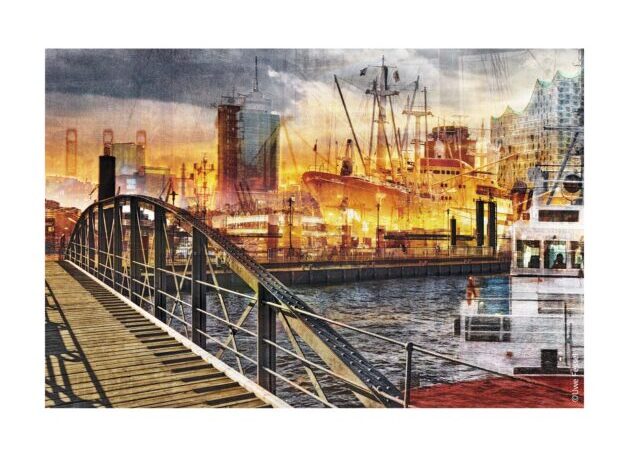When it comes to wide format printing, choosing the right photo paper can make a significant difference in the quality and appearance of your prints. Whether you’re printing photographs, banners, or posters, understanding the types of photo paper available, their advantages, GSM, and thickness is essential for achieving the best results. In this guide, we’ll walk you through the different types of photo paper used in wide format printing and help you select the best option for your project.
1. Glossy Photo Paper
Features: Glossy photo paper is characterized by its shiny, reflective finish, which brings out vibrant colors and deep contrasts. It’s a popular choice for photo prints and promotional materials where high image quality is a priority.
Advantages:
- Brilliant, high-contrast images
- Great for printing photos with a lot of detail
- Suitable for high-resolution prints
GSM and Thickness: Glossy photo paper typically comes in 190 to 260 GSM (grams per square meter), with a thickness that supports sharp images without being too stiff.
Best Uses: This paper is ideal for printing photographs, posters, and high-end promotional materials, offering a professional finish that catches attention.
2. Satin Photo Paper
Features: Satin photo paper has a semi-gloss finish, providing a middle ground between glossy and matte paper. It offers a soft sheen without the high reflectivity of glossy paper, making it perfect for images where glare could be a concern.
Advantages:
- Reduces glare while retaining vibrant colors
- Provides a more subtle finish compared to glossy paper
- Fingerprints and smudges are less noticeable
GSM and Thickness: Satin photo paper typically ranges from 170 to 260 GSM, offering good durability and a slightly softer texture than gloss.
Best Uses: Satin photo paper is great for family portraits, promotional signage, and artwork, balancing quality with a softer, more natural look.
3. Luster Photo Paper
Features: Luster photo paper falls between glossy and matte, with a slight texture that minimizes reflections. It enhances the depth of colors while giving prints a professional, fine-art feel.
Advantages:
- Excellent color depth and clarity
- Minimal reflections with a subtle sheen
- Fingerprint-resistant due to its textured surface
GSM and Thickness: Luster photo paper is commonly found in 240 to 300 GSM, providing a thicker, more durable option for high-quality prints.
Best Uses: Luster photo paper is popular for wedding photos, professional portraits, and gallery prints, offering a sophisticated and durable finish.
4. Matte Photo Paper
Features: Matte photo paper is non-reflective, making it ideal for prints that will be displayed under bright lights. This paper type absorbs more ink, resulting in softer colors and a more subdued finish.
Advantages:
- No glare or reflections
- Ideal for prints that require easy readability
- Softer color output suitable for artistic prints
GSM and Thickness: Matte photo paper ranges from 160 to 230 GSM, which gives it a lighter feel while still supporting quality prints.
Best Uses: Matte paper is a great choice for graphic design prints, architectural drawings, and other projects where detail is crucial, but reflections are unwanted.
5. Instant Dry Photo Paper
Features: Instant dry photo paper, often available in glossy or satin finishes, is designed to dry ink quickly, making it perfect for high-volume printing environments. The quick-drying feature prevents smudging and allows immediate handling.
Advantages:
- Fast drying to prevent smudges
- Perfect for high-volume and quick turnaround projects
- Available in various finishes, including gloss and satin
GSM and Thickness: Instant dry photo paper typically comes in 190 to 250 GSM, providing a balance between quick-drying features and print durability.
Best Uses: Best for fast-paced environments like print shops where quick production is necessary without sacrificing quality.
Key Considerations for Choosing Wide Format Photo Paper
- GSM and Thickness: The GSM of the paper influences both the durability and the overall feel of your print. Higher GSM papers are thicker and more robust, while lower GSM papers are lightweight and flexible.
- Finish and Glare: If you’re printing for outdoor displays or areas with bright lighting, choosing a non-reflective paper like matte or satin can reduce glare. Glossy papers, on the other hand, work well in controlled lighting for photo displays.
- Color Accuracy and Vibrancy: Glossy and luster photo papers offer excellent color depth, making them ideal for photo-heavy projects, while matte papers are suited for designs with text and muted tones.
- Drying Time: If you’re working on a tight deadline, instant dry photo papers can save time by reducing the risk of smudging and allowing for immediate handling.
Conclusion
Wide format printing offers endless possibilities, but choosing the right photo paper is key to ensuring your prints look professional, vibrant, and durable. From glossy for high-definition photos to matte for detailed graphics, each type of photo paper has its own advantages and applications. By considering factors such as GSM, thickness, finish, and drying time, you can select the perfect photo paper for your next project, whether you’re printing a family portrait, gallery piece, or promotional poster.
Additional Information:
While GSM (grams per square meter) and thickness often correlate, they don’t always go hand in hand. GSM measures the paper’s weight, whereas thickness refers to how thick the paper is physically. Here’s how they differ:
GSM (Weight): This measurement tells you how much the paper weighs over a square meter. The higher the GSM, the heavier and denser the paper tends to be, but it doesn’t always mean the paper will be thicker.
Thickness: Measured in microns or millimeters, thickness indicates how thick the paper is physically. Some papers can be thick but lightweight due to their material composition, while others might be heavier but thinner.
For instance, coated papers (like glossy photo paper) may have a higher GSM but feel thinner due to their composition, while uncoated papers (like matte papers) can be bulkier with a lower GSM.
In summary, while higher GSM papers tend to feel thicker, GSM and thickness aren’t always directly proportional, as different coatings and materials can affect these characteristics independently.



